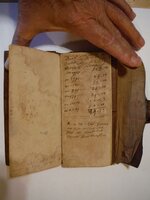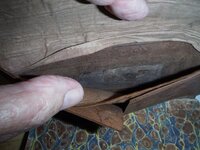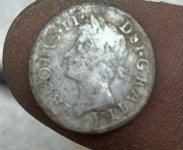TheInspector
Sr. Member
- Jul 22, 2012
- 281
- 224
- Detector(s) used
-
Tesoro Sand Shark.......
Garrett AT Gold...............
Garrett Pro-Pointer AT - AKA The Carrot
- Primary Interest:
- All Treasure Hunting
What appears to be Sam Houston's pocket ledger
My treasure story starts February 22nd 2013 when my Mother and I are discussing removing from her home some of the items left by her deceased husband. During this conversation she mentions she had tried to get him to have his Sam Houston book looked at to see if it was valuable, but by that time he was in his 90’s and really didn’t care. I said Sam Houston book? They had been together over 35 years and I had never heard of the Sam Houston book. I had been told his Great Grand Father fought at the Battle of San Jacinto under Sam Houston. My Mother said she thought he had received it from his father and it is in a drawer, so my response was lets’ see it. I describe what she brought out to me as a leather bound pocket ledger. Contained within are notations that appear to be records of currency and scrip trading. These notations mostly say something along the lines of - received of NAME, $50.00 bill old star, followed by the # on the bill, signed Sam Houston. There appears to be five places where these signatures were made, but one appears to be gone due to water damage and one is faded. My mother and I took a ride to the San Jacinto Museum located just outside of Houston to see if there were any experts to look at it, but the curator was not in. In the next couple of weeks my mother contacted a local forensic document expert who took custody for a little over a week and concluded the leather bound ledger and paper was consistent with the time period and the ledger contained writings and signatures of Sam Houston, although all writing was not in his hand. There is a note on the last page written upside down that is mostly unintelligible but has the date 25 Sept 1888 which is several years after Sam Houston’s death.
The photos I have attached were taken with my camera phone the first time I saw this item. I have only recently seen the ledger again, when delivering it into the hands of Heritage Auction House for a free appraisal. At this time I chose not to spread the pages for photos since Heritage was about to examine it, and I was concerned about excess wear and tear. The ledger may be a part of Heritages March 2016 Texana auction, assuming the ledger passes their examination and we agree to terms of the auction.
I have looked at many letters and documents attributed to Sam Houston and see many similarities and dissimilarities in writings and signatures. Usually you see the ceremonial type of signature with a lot of flourish, but in this case the signatures were made in a small ledger, possibly while handheld. I have a lot more questions than answers at this point, such as why Sam Houston would sign the ledger if he was receiving items in trade from these different people.
I have tried to decipher the names contained within and believe I have identified three of the individuals and have established a connection to Sam Houston with two of them.
Among them are: John Allen Veatch, William Slaughter, A.M. Grinage.
If the military scrip #s recorded as received from Veatch could be found in an archives to have been issued to Captain J.A. Veatch, it would prove his identity.
If the old star Texas currency with matching # could be located, I believe it would be more valuable as proven to have once been in Sam Houston’s possession.
I am supposed to hear back from Heritage on the Monday the 22nd.
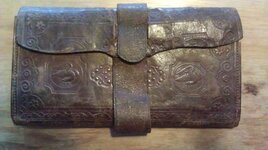
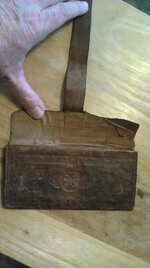
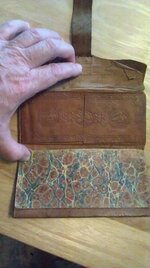
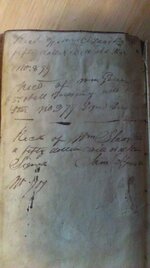
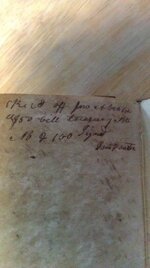
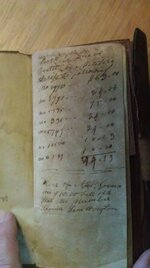
My treasure story starts February 22nd 2013 when my Mother and I are discussing removing from her home some of the items left by her deceased husband. During this conversation she mentions she had tried to get him to have his Sam Houston book looked at to see if it was valuable, but by that time he was in his 90’s and really didn’t care. I said Sam Houston book? They had been together over 35 years and I had never heard of the Sam Houston book. I had been told his Great Grand Father fought at the Battle of San Jacinto under Sam Houston. My Mother said she thought he had received it from his father and it is in a drawer, so my response was lets’ see it. I describe what she brought out to me as a leather bound pocket ledger. Contained within are notations that appear to be records of currency and scrip trading. These notations mostly say something along the lines of - received of NAME, $50.00 bill old star, followed by the # on the bill, signed Sam Houston. There appears to be five places where these signatures were made, but one appears to be gone due to water damage and one is faded. My mother and I took a ride to the San Jacinto Museum located just outside of Houston to see if there were any experts to look at it, but the curator was not in. In the next couple of weeks my mother contacted a local forensic document expert who took custody for a little over a week and concluded the leather bound ledger and paper was consistent with the time period and the ledger contained writings and signatures of Sam Houston, although all writing was not in his hand. There is a note on the last page written upside down that is mostly unintelligible but has the date 25 Sept 1888 which is several years after Sam Houston’s death.
The photos I have attached were taken with my camera phone the first time I saw this item. I have only recently seen the ledger again, when delivering it into the hands of Heritage Auction House for a free appraisal. At this time I chose not to spread the pages for photos since Heritage was about to examine it, and I was concerned about excess wear and tear. The ledger may be a part of Heritages March 2016 Texana auction, assuming the ledger passes their examination and we agree to terms of the auction.
I have looked at many letters and documents attributed to Sam Houston and see many similarities and dissimilarities in writings and signatures. Usually you see the ceremonial type of signature with a lot of flourish, but in this case the signatures were made in a small ledger, possibly while handheld. I have a lot more questions than answers at this point, such as why Sam Houston would sign the ledger if he was receiving items in trade from these different people.
I have tried to decipher the names contained within and believe I have identified three of the individuals and have established a connection to Sam Houston with two of them.
Among them are: John Allen Veatch, William Slaughter, A.M. Grinage.
If the military scrip #s recorded as received from Veatch could be found in an archives to have been issued to Captain J.A. Veatch, it would prove his identity.
If the old star Texas currency with matching # could be located, I believe it would be more valuable as proven to have once been in Sam Houston’s possession.
I am supposed to hear back from Heritage on the Monday the 22nd.






Last edited:


